Jinze Bai
A Spark of Vision-Language Intelligence: 2-Dimensional Autoregressive Transformer for Efficient Finegrained Image Generation
Oct 02, 2024



Abstract:This work tackles the information loss bottleneck of vector-quantization (VQ) autoregressive image generation by introducing a novel model architecture called the 2-Dimensional Autoregression (DnD) Transformer. The DnD-Transformer predicts more codes for an image by introducing a new autoregression direction, \textit{model depth}, along with the sequence length direction. Compared to traditional 1D autoregression and previous work utilizing similar 2D image decomposition such as RQ-Transformer, the DnD-Transformer is an end-to-end model that can generate higher quality images with the same backbone model size and sequence length, opening a new optimization perspective for autoregressive image generation. Furthermore, our experiments reveal that the DnD-Transformer's potential extends beyond generating natural images. It can even generate images with rich text and graphical elements in a self-supervised manner, demonstrating an understanding of these combined modalities. This has not been previously demonstrated for popular vision generative models such as diffusion models, showing a spark of vision-language intelligence when trained solely on images. Code, datasets and models are open at https://github.com/chenllliang/DnD-Transformer.
Qwen2-VL: Enhancing Vision-Language Model's Perception of the World at Any Resolution
Sep 18, 2024



Abstract:We present the Qwen2-VL Series, an advanced upgrade of the previous Qwen-VL models that redefines the conventional predetermined-resolution approach in visual processing. Qwen2-VL introduces the Naive Dynamic Resolution mechanism, which enables the model to dynamically process images of varying resolutions into different numbers of visual tokens. This approach allows the model to generate more efficient and accurate visual representations, closely aligning with human perceptual processes. The model also integrates Multimodal Rotary Position Embedding (M-RoPE), facilitating the effective fusion of positional information across text, images, and videos. We employ a unified paradigm for processing both images and videos, enhancing the model's visual perception capabilities. To explore the potential of large multimodal models, Qwen2-VL investigates the scaling laws for large vision-language models (LVLMs). By scaling both the model size-with versions at 2B, 8B, and 72B parameters-and the amount of training data, the Qwen2-VL Series achieves highly competitive performance. Notably, the Qwen2-VL-72B model achieves results comparable to leading models such as GPT-4o and Claude3.5-Sonnet across various multimodal benchmarks, outperforming other generalist models. Code is available at \url{https://github.com/QwenLM/Qwen2-VL}.
Qwen2 Technical Report
Jul 16, 2024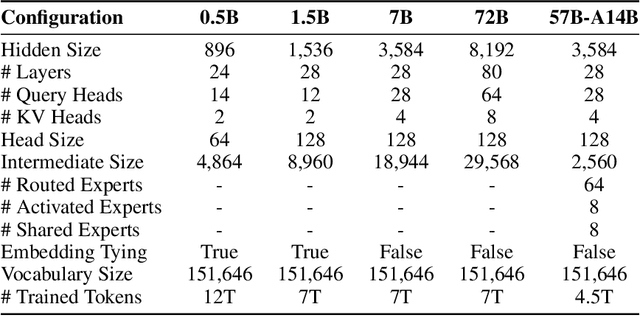
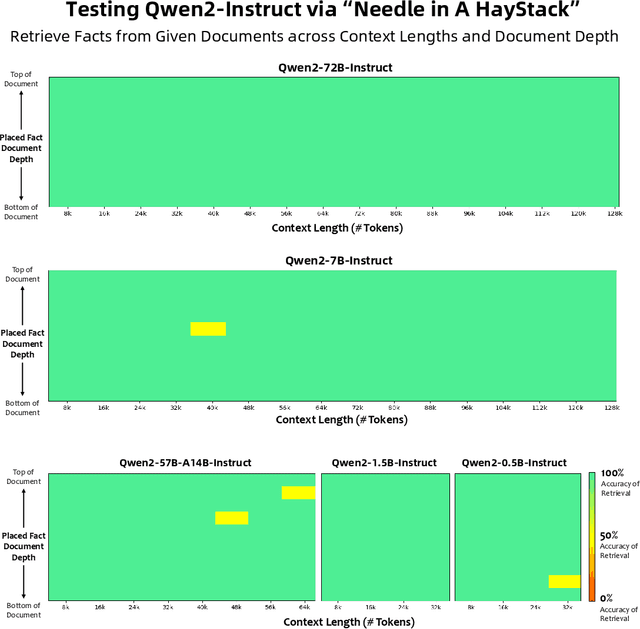
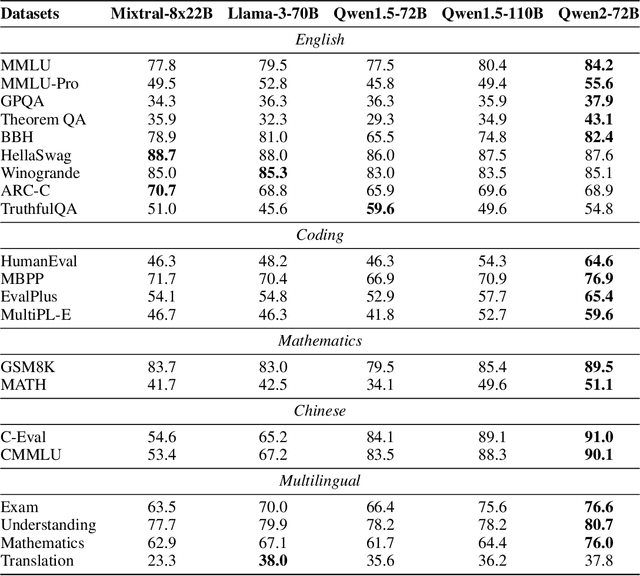
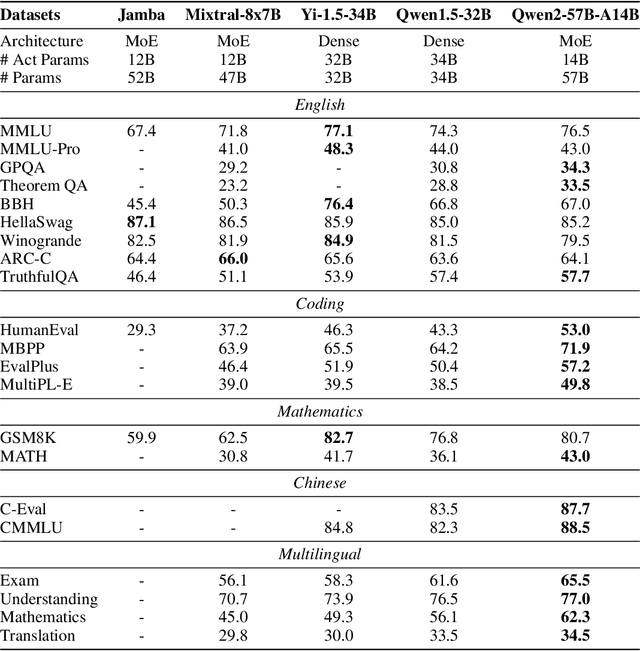
Abstract:This report introduces the Qwen2 series, the latest addition to our large language models and large multimodal models. We release a comprehensive suite of foundational and instruction-tuned language models, encompassing a parameter range from 0.5 to 72 billion, featuring dense models and a Mixture-of-Experts model. Qwen2 surpasses most prior open-weight models, including its predecessor Qwen1.5, and exhibits competitive performance relative to proprietary models across diverse benchmarks on language understanding, generation, multilingual proficiency, coding, mathematics, and reasoning. The flagship model, Qwen2-72B, showcases remarkable performance: 84.2 on MMLU, 37.9 on GPQA, 64.6 on HumanEval, 89.5 on GSM8K, and 82.4 on BBH as a base language model. The instruction-tuned variant, Qwen2-72B-Instruct, attains 9.1 on MT-Bench, 48.1 on Arena-Hard, and 35.7 on LiveCodeBench. Moreover, Qwen2 demonstrates robust multilingual capabilities, proficient in approximately 30 languages, spanning English, Chinese, Spanish, French, German, Arabic, Russian, Korean, Japanese, Thai, Vietnamese, and more, underscoring its versatility and global reach. To foster community innovation and accessibility, we have made the Qwen2 model weights openly available on Hugging Face and ModelScope, and the supplementary materials including example code on GitHub. These platforms also include resources for quantization, fine-tuning, and deployment, facilitating a wide range of applications and research endeavors.
Qwen Technical Report
Sep 28, 2023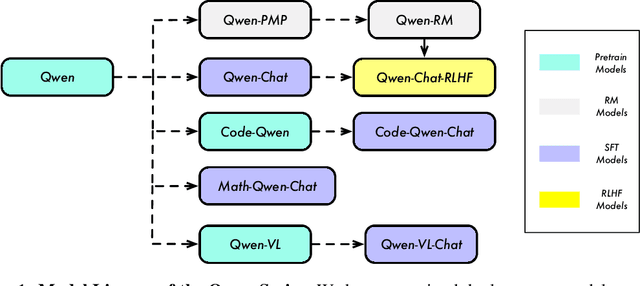

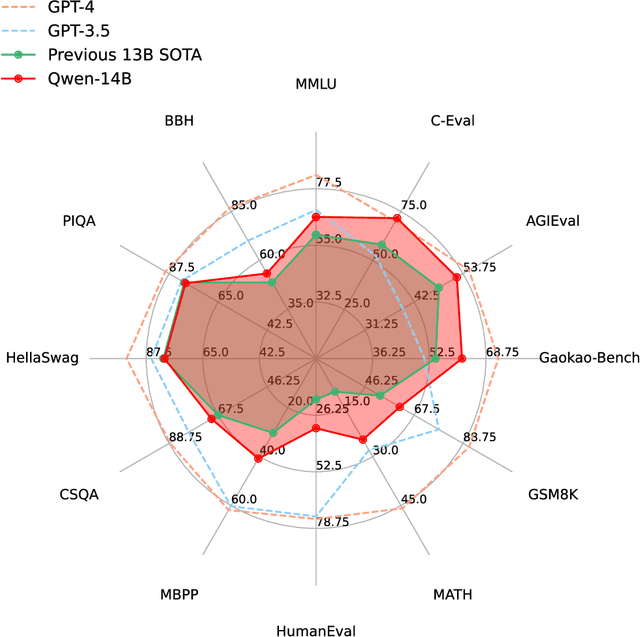
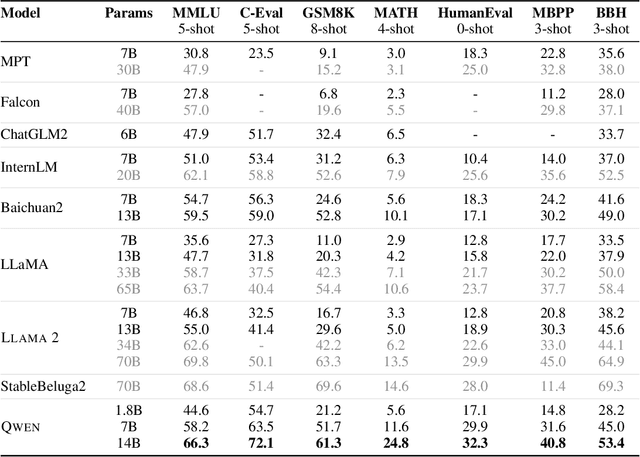
Abstract:Large language models (LLMs) have revolutionized the field of artificial intelligence, enabling natural language processing tasks that were previously thought to be exclusive to humans. In this work, we introduce Qwen, the first installment of our large language model series. Qwen is a comprehensive language model series that encompasses distinct models with varying parameter counts. It includes Qwen, the base pretrained language models, and Qwen-Chat, the chat models finetuned with human alignment techniques. The base language models consistently demonstrate superior performance across a multitude of downstream tasks, and the chat models, particularly those trained using Reinforcement Learning from Human Feedback (RLHF), are highly competitive. The chat models possess advanced tool-use and planning capabilities for creating agent applications, showcasing impressive performance even when compared to bigger models on complex tasks like utilizing a code interpreter. Furthermore, we have developed coding-specialized models, Code-Qwen and Code-Qwen-Chat, as well as mathematics-focused models, Math-Qwen-Chat, which are built upon base language models. These models demonstrate significantly improved performance in comparison with open-source models, and slightly fall behind the proprietary models.
Qwen-VL: A Versatile Vision-Language Model for Understanding, Localization, Text Reading, and Beyond
Sep 14, 2023


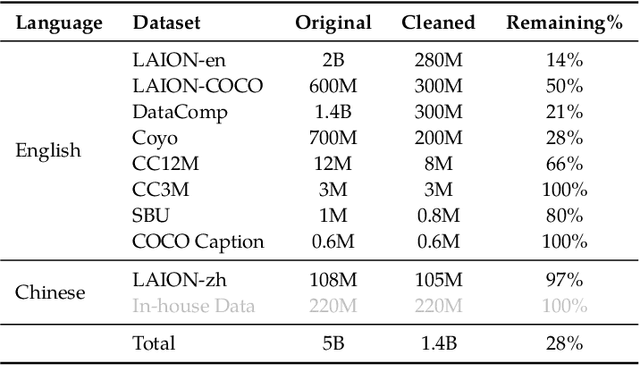
Abstract:We introduce the Qwen-VL series, a set of large-scale vision-language models (LVLMs) designed to perceive and understand both text and images. Comprising Qwen-VL and Qwen-VL-Chat, these models exhibit remarkable performance in tasks like image captioning, question answering, visual localization, and flexible interaction. The evaluation covers a wide range of tasks including zero-shot captioning, visual or document visual question answering, and grounding. We demonstrate the Qwen-VL outperforms existing LVLMs. We present their architecture, training, capabilities, and performance, highlighting their contributions to advancing multimodal artificial intelligence. Code, demo and models are available at https://github.com/QwenLM/Qwen-VL.
TouchStone: Evaluating Vision-Language Models by Language Models
Sep 04, 2023Abstract:Large vision-language models (LVLMs) have recently witnessed rapid advancements, exhibiting a remarkable capacity for perceiving, understanding, and processing visual information by connecting visual receptor with large language models (LLMs). However, current assessments mainly focus on recognizing and reasoning abilities, lacking direct evaluation of conversational skills and neglecting visual storytelling abilities. In this paper, we propose an evaluation method that uses strong LLMs as judges to comprehensively evaluate the various abilities of LVLMs. Firstly, we construct a comprehensive visual dialogue dataset TouchStone, consisting of open-world images and questions, covering five major categories of abilities and 27 subtasks. This dataset not only covers fundamental recognition and comprehension but also extends to literary creation. Secondly, by integrating detailed image annotations we effectively transform the multimodal input content into a form understandable by LLMs. This enables us to employ advanced LLMs for directly evaluating the quality of the multimodal dialogue without requiring human intervention. Through validation, we demonstrate that powerful LVLMs, such as GPT-4, can effectively score dialogue quality by leveraging their textual capabilities alone, aligning with human preferences. We hope our work can serve as a touchstone for LVLMs' evaluation and pave the way for building stronger LVLMs. The evaluation code is available at https://github.com/OFA-Sys/TouchStone.
OFASys: A Multi-Modal Multi-Task Learning System for Building Generalist Models
Dec 08, 2022



Abstract:Generalist models, which are capable of performing diverse multi-modal tasks in a task-agnostic way within a single model, have been explored recently. Being, hopefully, an alternative to approaching general-purpose AI, existing generalist models are still at an early stage, where modality and task coverage is limited. To empower multi-modal task-scaling and speed up this line of research, we release a generalist model learning system, OFASys, built on top of a declarative task interface named multi-modal instruction. At the core of OFASys is the idea of decoupling multi-modal task representations from the underlying model implementations. In OFASys, a task involving multiple modalities can be defined declaratively even with just a single line of code. The system automatically generates task plans from such instructions for training and inference. It also facilitates multi-task training for diverse multi-modal workloads. As a starting point, we provide presets of 7 different modalities and 23 highly-diverse example tasks in OFASys, with which we also develop a first-in-kind, single model, OFA+, that can handle text, image, speech, video, and motion data. The single OFA+ model achieves 95% performance in average with only 16% parameters of 15 task-finetuned models, showcasing the performance reliability of multi-modal task-scaling provided by OFASys. Available at https://github.com/OFA-Sys/OFASys
M6-10T: A Sharing-Delinking Paradigm for Efficient Multi-Trillion Parameter Pretraining
Oct 25, 2021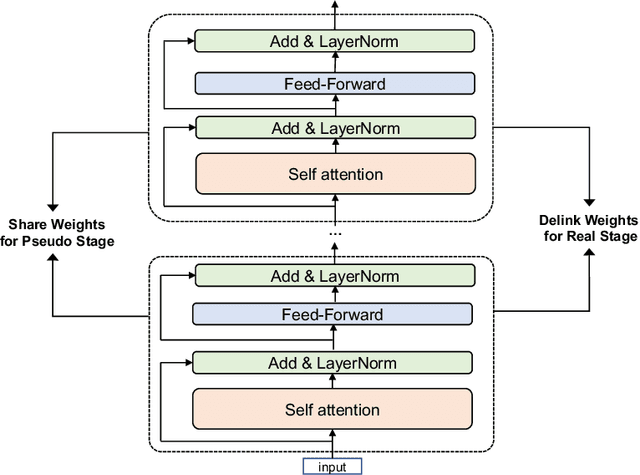

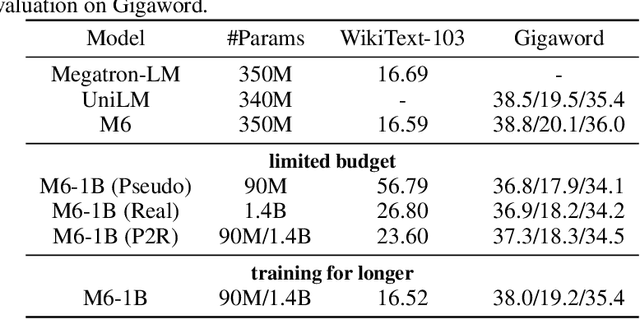
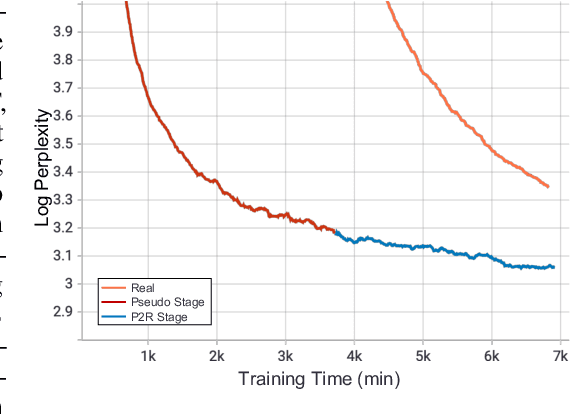
Abstract:Recent expeditious developments in deep learning algorithms, distributed training, and even hardware design for large models have enabled training extreme-scale models, say GPT-3 and Switch Transformer possessing hundreds of billions or even trillions of parameters. However, under limited resources, extreme-scale model training that requires enormous amounts of computes and memory footprint suffers from frustratingly low efficiency in model convergence. In this paper, we propose a simple training strategy called "Pseudo-to-Real" for high-memory-footprint-required large models. Pseudo-to-Real is compatible with large models with architecture of sequential layers. We demonstrate a practice of pretraining unprecedented 10-trillion-parameter model, an order of magnitude larger than the state-of-the-art, on solely 512 GPUs within 10 days. Besides demonstrating the application of Pseudo-to-Real, we also provide a technique, Granular CPU offloading, to manage CPU memory for training large model and maintain high GPU utilities. Fast training of extreme-scale models on a decent amount of resources can bring much smaller carbon footprint and contribute to greener AI.
Personalized Bundle List Recommendation
Apr 03, 2019

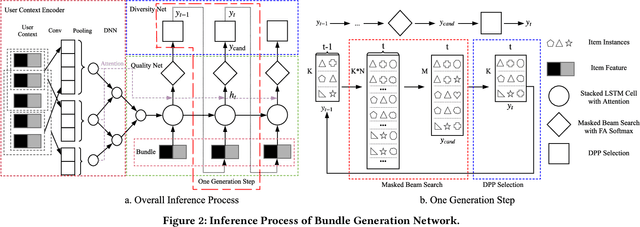

Abstract:Product bundling, offering a combination of items to customers, is one of the marketing strategies commonly used in online e-commerce and offline retailers. A high-quality bundle generalizes frequent items of interest, and diversity across bundles boosts the user-experience and eventually increases transaction volume. In this paper, we formalize the personalized bundle list recommendation as a structured prediction problem and propose a bundle generation network (BGN), which decomposes the problem into quality/diversity parts by the determinantal point processes (DPPs). BGN uses a typical encoder-decoder framework with a proposed feature-aware softmax to alleviate the inadequate representation of traditional softmax, and integrates the masked beam search and DPP selection to produce high-quality and diversified bundle list with an appropriate bundle size. We conduct extensive experiments on three public datasets and one industrial dataset, including two generated from co-purchase records and the other two extracted from real-world online bundle services. BGN significantly outperforms the state-of-the-art methods in terms of quality, diversity and response time over all datasets. In particular, BGN improves the precision of the best competitors by 16\% on average while maintaining the highest diversity on four datasets, and yields a 3.85x improvement of response time over the best competitors in the bundle list recommendation problem.
ATRank: An Attention-Based User Behavior Modeling Framework for Recommendation
Nov 27, 2017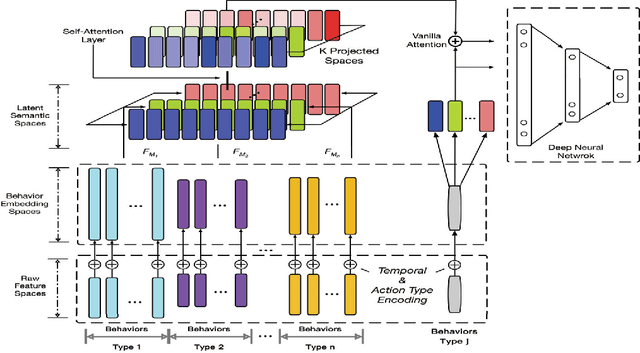

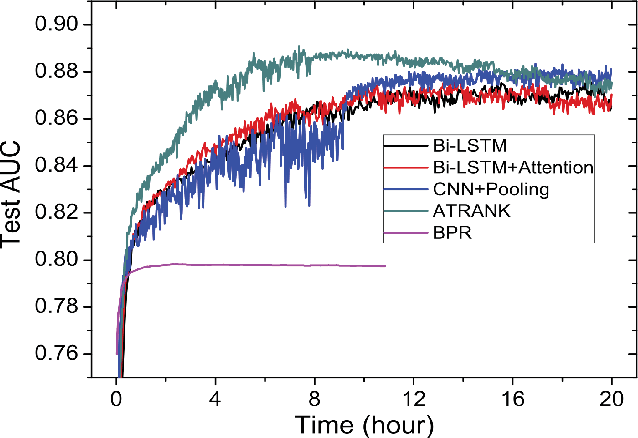

Abstract:A user can be represented as what he/she does along the history. A common way to deal with the user modeling problem is to manually extract all kinds of aggregated features over the heterogeneous behaviors, which may fail to fully represent the data itself due to limited human instinct. Recent works usually use RNN-based methods to give an overall embedding of a behavior sequence, which then could be exploited by the downstream applications. However, this can only preserve very limited information, or aggregated memories of a person. When a downstream application requires to facilitate the modeled user features, it may lose the integrity of the specific highly correlated behavior of the user, and introduce noises derived from unrelated behaviors. This paper proposes an attention based user behavior modeling framework called ATRank, which we mainly use for recommendation tasks. Heterogeneous user behaviors are considered in our model that we project all types of behaviors into multiple latent semantic spaces, where influence can be made among the behaviors via self-attention. Downstream applications then can use the user behavior vectors via vanilla attention. Experiments show that ATRank can achieve better performance and faster training process. We further explore ATRank to use one unified model to predict different types of user behaviors at the same time, showing a comparable performance with the highly optimized individual models.
 Add to Chrome
Add to Chrome Add to Firefox
Add to Firefox Add to Edge
Add to Edge